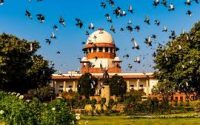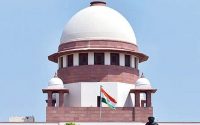$100 Website Offer
Get your personal website + domain for just $100.
Limited Time Offer!
Claim Your Website NowClarence Thomas: From ‘Black Panther Type’ To Supreme Court’s Conservative Beacon
Source:npr.org
On the U.S. Supreme Court, where nine justices often disagree but try to meld their views into majority decisions, one justice stands out.
Clarence Thomas, the longest-serving member of the current court — and its only African American — has views that perhaps can be described only as unique.
Some court watchers, however, use other terms: idiosyncratic, eccentric, provocative, thoughtful and, yes, wacky.
“He’s gone through all sorts of different ideologies in his life,” observes Yale Law School professor Akhil Amar. “In law school, he was a Black Panther type, a black power extremist of a certain sort. Now, he defines the right wing of the United States Supreme Court.”
As he has in the past, Thomas this term has charted a course that is, at times, breathtakingly different from those of his colleagues. While he wrote eight majority opinions for the court this term, it was his 18 dissenting and concurring opinions that raised eyebrows.
An array of extraordinary opinions
In Thomas’ most eye-catching separate decisions this term, he only occasionally attracted the vote of even one other justice. Here’s a selection:
- He dissented when the court invalidated the conviction of a black man tried six times for the same crime by the same prosecutor with juries that were either all white or nearly all white.
- He once again wrote that the constitution’s ban on government establishment of religion does not apply to the states — in other words, that states are free to prefer or endorse one religion over another.
- He twice called on the court to reverse its abortion decisions, in one case going further to link birth control and Planned Parenthood to the eugenics movement of a century ago.
- For the first time, he called for overturning Gideon v. Wainwright, the 1963 landmark decision requiring that criminal defendants too poor to pay for a lawyer be provided an attorney paid for by the government.
- In another first, he called for overturning the 1964 landmark freedom-of-the-press decision New York Times v. Sullivan, which set in place standards to make it more difficult for public figures to sue for libel without proof that falsehoods were knowingly published.
Thomas’ newfound objection to a landmark libel decision that has been reaffirmed countless times was not joined by any other justice, but it does coincide with President Trump’s views.
Trump, as a private citizen, repeatedly and unsuccessfully tried to sue his critics in the media. And he has made no secret of his fury over the state of the nation’s libel laws.
At a campaign rally in 2016, Trump attacked the New York Times and the Washington Post, declaring, “I’m gonna open up our libel laws, so when they write purposely negative and horrible and false articles, we can sue them and win lots of money.”
It is a pledge he has frequently repeated since then.
Trump has been particularly solicitous of Thomas and his wife, Ginni, a vocal conservative activist. The Thomases dined with the Trumps at the White House earlier this year; soon thereafter, Ginni Thomas led a one-hour meeting between the president and a group of her fellow hard-line socially conservative activists.
The Trump-Thomas relationship may have been responsible for retirement rumors, fueled by some conservatives, who apparently wanted the 71-year-old Thomas to step down so that Trump could replace him with a younger conservative appointee for decades longer.
If that was the plan, it didn’t work, as Thomas made clear during an appearance at Pepperdine University when he was asked what he might say at his retirement party in 20 years.
But I’m not retiring,” he told the interviewer, who queried, “Not in 20 years?”
“No,” replied Thomas with a laugh.
“Not in 30 years?” the interviewer persisted.
“No,” added Thomas, emphatically.
Now, nobody really thinks Thomas will still be on the Supreme Court when he is 101, but in this and other appearances, he has quite clearly rejected the idea of retiring anytime soon.
Theories from black nationalism to originalism
In each of his 28 years on the nation’s highest court, Thomas has seen critics and supporters alike positing different theories about his jurisprudence.
Brooklyn College professor Corey Robin, author of the forthcoming book The Enigma of Clarence Thomas, contends that Thomas’ overriding legal philosophy stems from his views as a “black nationalist.”
“The way I understand Thomas is that he believes that the American state, in particular, is imbued with race and racial consciousness,” Robin said, “and he thinks it’s kind of a fool’s errand to try to change that.”
In Robin’s view, Thomas’ dissent in this term’s jury discrimination case fits in perfectly. The solution to white prosecutors trying to exclude black jurors because of their race is to allow defense lawyers to exclude white jurors because of their race too.
An entirely different view of Thomas comes from Ralph Rossum, a professor at Claremont McKenna College and author of Understanding Clarence Thomas. Rossum said Thomas disdains prior Supreme Court rulings because they get him further and further away from the original Constitution.
“If you have a finely wrought piece of furniture and you put layer and layer of paint on it, pretty soon all the detail is lost under the coats of paint,” Rossum said, “and what Thomas wants to do is scrape back to bare wood, to the original text” of the Constitution.
But even the man who made originalism popular, the late Justice Antonin Scalia, did not have such a purist view. Unlike Thomas, he did believe in precedent. As he famously put it, “I am an originalist, but I’m not a nut.”
Supreme Court precedents are the building blocks of the law and of an ordered society, said University of Baltimore law professor Garrett Epps. He sees Thomas’ view of precedent as arrogant.
As an example, he points to a 1995 concurring opinion in which Thomas referred to James Madison’s views on separation of church and state as “extreme” and said that “in any event the views of one man do not establish the original meaning of the First Amendment” religion clauses.
“Wait a minute,” said Epps, his voice rising. “You just called James Madison, the father of the Bill of Rights … you just called him an extremist, particularly in the area of religious freedom, which is the area he is most identified with.”
Epps maintains that if you read Thomas’ jurisprudence, the views of only one man count — his own. Thomas “alone knows the original meaning of these provisions,” Epps said, “and even Madison, who wrote them, can be disregarded.”
Epps added, “Now that takes a level of confidence or megalomania that I find really breathtaking.”
The measure of success
It is, however, important not to dismiss Thomas’ views. Yale’s Amar acknowledges that Thomas has not written many high-visibility majority opinions for the court, but that may not be what matters most at this moment with a newly conservative court majority.
“If you think that the measure of success of a justice is how many majority opinions he writes, well then Thomas ranks somewhat lower,” Amar said. “But if instead the game is scored by how many new ideas someone gets into the conversation and eventually wins on, well, then Thomas is way high in the pecking order.”
Thomas, for instance, did not write the court’s landmark 2008 decision declaring for the first time that the Second Amendment right to bear arms includes an individual right to own a gun in one’s home for self-defense. Scalia wrote that decision, but the first justice to propose that idea was Thomas, in a concurring opinion 11 years earlier.
Still, Amar draws a distinction between the gun rights decision and other decisions that Thomas criticized this term. The right to a fair trial, guaranteed by the Constitution, is so “foundational,” Amar said, and so embraced by courts and scholars that he thinks it “unimaginable” that the Supreme Court would repudiate either Gideon v. Wainwright‘s right-to-counsel decision or a line of decisions barring racial discrimination in jury selection.
Similarly, he thinks it “unimaginable” that the Supreme Court would repudiate its landmark libel decision or that it would rethink its religion doctrine to allow state governments to prefer one religion over another.
But, “the one area where Justice Thomas might very well have five votes is abortion,” Amar said, adding, “That is the proverbial elephant in the room.”
But if the new conservative Supreme Court majority starts rethinking major and long-established precedents in other areas, Thomas will be leading the way.



